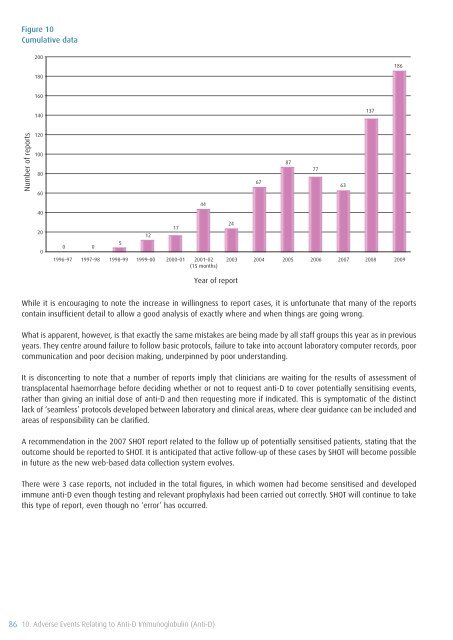SHOT Annual Report 2009 - Serious Hazards of Transfusion
SHOT Annual Report 2009 - Serious Hazards of Transfusion
SHOT Annual Report 2009 - Serious Hazards of Transfusion
You also want an ePaper? Increase the reach of your titles
YUMPU automatically turns print PDFs into web optimized ePapers that Google loves.
Figure 10<br />
Cumulative data<br />
200<br />
186<br />
180<br />
160<br />
140<br />
137<br />
Number <strong>of</strong> reports<br />
120<br />
100<br />
80<br />
60<br />
67<br />
87<br />
77<br />
63<br />
44<br />
40<br />
20<br />
0<br />
0<br />
1996–97<br />
0<br />
1997–98<br />
5<br />
1998–99<br />
12<br />
1999–00<br />
17<br />
2000–01<br />
2001–02<br />
(15 months)<br />
24<br />
2003<br />
2004<br />
2005<br />
2006<br />
2007 2008 <strong>2009</strong><br />
Year <strong>of</strong> report<br />
While it is encouraging to note the increase in willingness to report cases, it is unfortunate that many <strong>of</strong> the reports<br />
contain insufficient detail to allow a good analysis <strong>of</strong> exactly where and when things are going wrong.<br />
What is apparent, however, is that exactly the same mistakes are being made by all staff groups this year as in previous<br />
years. They centre around failure to follow basic protocols, failure to take into account laboratory computer records, poor<br />
communication and poor decision making, underpinned by poor understanding.<br />
It is disconcerting to note that a number <strong>of</strong> reports imply that clinicians are waiting for the results <strong>of</strong> assessment <strong>of</strong><br />
transplacental haemorrhage before deciding whether or not to request anti-D to cover potentially sensitising events,<br />
rather than giving an initial dose <strong>of</strong> anti-D and then requesting more if indicated. This is symptomatic <strong>of</strong> the distinct<br />
lack <strong>of</strong> ‘seamless’ protocols developed between laboratory and clinical areas, where clear guidance can be included and<br />
areas <strong>of</strong> responsibility can be clarified.<br />
A recommendation in the 2007 <strong>SHOT</strong> report related to the follow up <strong>of</strong> potentially sensitised patients, stating that the<br />
outcome should be reported to <strong>SHOT</strong>. It is anticipated that active follow-up <strong>of</strong> these cases by <strong>SHOT</strong> will become possible<br />
in future as the new web-based data collection system evolves.<br />
There were 3 case reports, not included in the total figures, in which women had become sensitised and developed<br />
immune anti-D even though testing and relevant prophylaxis had been carried out correctly. <strong>SHOT</strong> will continue to take<br />
this type <strong>of</strong> report, even though no ‘error’ has occurred.<br />
86 10. Adverse Events Relating to Anti-D Immunoglobulin (Anti-D)












